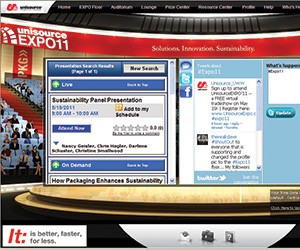As every planner knows, the troubled economy has encouraged a wealth of changes in meetings and conventions.
One of the emerging trends—spurred on by budget cuts and technological innovation—is the hybrid meeting, where a standard meeting or event is complemented with virtual components such as live webcasts, webinars, Twitter feeds and Facebook posts.
When you consider that 65 percent of Americans have a mobile communications device within three feet of them at all times, it’s not surprising that hybrid meetings are here to stay.
Hybrids Help
“When the economy took a dive about five years ago, people cut budgets and reduced travel, which created the perfect environment for the hybrid meeting to thrive,” says Mark Prine, divisional vice president of major accounts for USMotivation, a 50-year-old incentive and meeting planning company based in Atlanta.
That being said, most expert voices see the hybrid as a complement to—and not a substitute for—physical events.
“The hybrid is an important tool today, but it does not replace the in-person experience,” says Carol McGury, senior vice president of education and learning services at SmithBucklin, a Chicago-based association management and professional services company that executes more than 1,500 client webcasts and virtual meetings annually. “Face-to-face interaction is invaluable, but a well-planned and executed hybrid event is a way to keep others informed and offers great possibilities for on-demand content.”
While hybrid elements are used in everything from huge conventions to board member meetings, the concept is especially appealing to small and midsize events and meetings, which aren’t promoted as widely as annual conferences.
“In-person networking and socialization is still a very important part of the annual meeting experience,” says Lisa Williams, product manager, mobile and virtual solutions for USMotivation. “Events like quarterly meetings, town halls and small conferences are a great benefit to virtual attendees who can’t attend in person because they’re heavily involved in other projects and day-to-day operations.” PageBreak
The Real World
Like the wide variety of hybrid vehicles available at your typical auto dealership, from compacts to SUVs, hybrid meetings come in many different forms and designs.
“The technology exists to do amazing things, but it’s important to establish concise goals for a virtual meeting and understand the capabilities of the equipment and how it will enhance the virtual experience,” says Tom Stoffo, director of information technology at Tampa, Fla.-based Mainsail Lodging & Development, who was recently honored by the Hospitality Financial and Technology Professionals as the 2013 Certified Hospitality Technology Professional of the Year.
SmithBucklin recently executed a hybrid event for the Independent Oracle Users Group (IOUG) in Denver. More than 1,000 people physically attended the four-day event, which cost $1,500 for in-person participants and $299 for virtual attendees, of which there more than 200.
Forty live sessions of the annual conference were streamed online and were subsequently available for purchase by members on IOUG’s website. The offering resulted in a 20 percent boost in annual revenues.
“The on-demand format is a component that gives businesses and organizations a convenient way for their key people to access valuable content and perhaps lead to additional revenue for organizations,” McGury says. “The hybrid model can extend the life of the meeting.”
In an event for a professional international software organization, SmithBucklin was asked to expand the reach of the organization’s annual conference. It designed one five-session track of educational sessions for those that couldn’t attend the real-time virtual conference. The sessions attracted 130 new participants and were archived for later on-demand viewing.
Shimmer Events in Philadelphia added a virtual component for an East Coast U.S.-based international pharmaceutical company staging a meeting for 25 high-level executives in Amsterdam, the Netherlands.
“One of the key people involved in the meeting had a schedule conflict, so a decision was made to add a virtual component,” says Jeff Cesari, creative director at Shimmer Events. “We designed the meeting so he and others at the U.S. headquarters could watch and listen to the presentations.”
The virtual attendees watched slides and listened to speakers in real time, but couldn’t interact with in-person attendees, Cesari says.
“The hybrid concept provided an excellent option for those who couldn’t attend for schedule or other reasons,” Cesari adds.
He estimates the company saved approximately $65,000 on those who did not attend the Amsterdam meeting.
For small groups, SmithBucklin has coordinated live Twitter meet-ups, where virtual participants can tweet questions to the speaker or in-room attendees and follow feeds at their computer or on a smart phone. PageBreak
Important Issues
Hybrid meetings save money by cutting down on travel costs and increasing in-office production time by key employees, plus they’re a good ROI in other ways.
“You don’t have to fly and feed as many people so it’s a green way to have a meeting and gives companies another method to reduce their carbon footprint,” Cesari says.
From a budget standpoint, hybrid meetings are also attractive to companies who want younger and newer employees to benefit from the meeting, but can’t justify the cost of transporting them to the site.
Realistically, though, hybrid meetings aren’t always the solution. For instance, if you want people to be emotionally moved and excited, a fully virtual meeting is not the best setting.
A dynamic speaker or virtual emcee is key in a successful hybrid meeting.
“You can have all of the technological bells and whistles but the speakers have to be more creative and exciting so the virtual meeting attendee is attentive and engaged,” Stoffo says. “Good speakers and facilitators play an important role in setting the tone and focus of a virtual meeting.
“Planners should not skimp on equipment for virtual meetings,” he continues, “because most people these days are accustomed to high-definition screens and have elevated expectations for electronic products.”
One of the common problems with virtual meetings is that technology is not always flawless.
“There are all sorts of operational, firewall and bandwidth issues,” McGury says, “so having a top-notch tech person or staff on-site is imperative.”
Edward Schmidt Jr. is an Orlando-based freelance writer who lives in a world of texts, tweets and posts.






